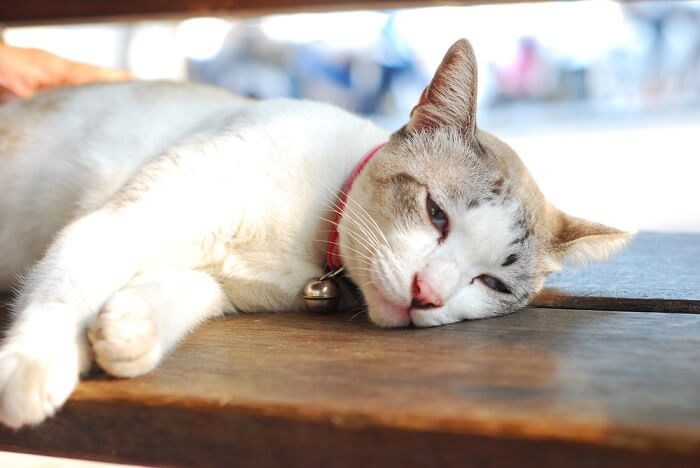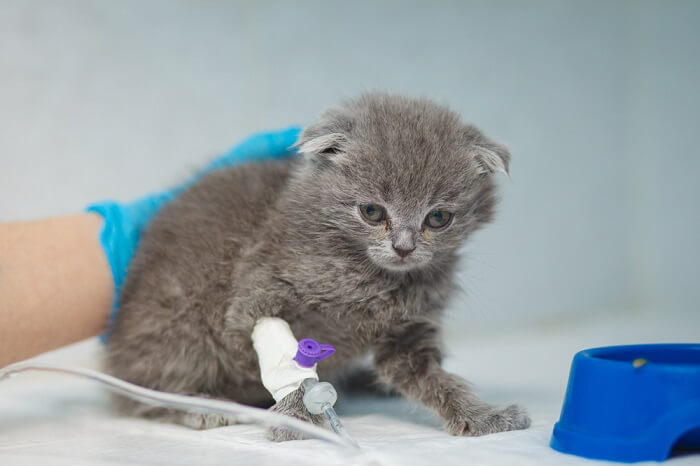
This article aims to explain the details of bone marrow disease in cats, a common and serious problem. The aim of this article is to provide a simple, clear explanation about the types of issues that can affect feline bone marrow disease to help cat owners understand what may be going on if their pets are affected.
Quick Overview: Bone Marrow Disease In Cats







Where Is Bone Marrow in Cats, and What Is Its Role?
Bone marrow is present as an inside core of most of a cat’s bones. It’s a soft, spongy red-colored substance, responsible for the production of blood cells, including both red blood cells and white blood cells, as well as platelets.
What Is Bone Marrow Disease?
Bone marrow disease refers to any condition where the bone marrow stops functioning normally.
It could also be referred to as bone marrow failure. There are a number of different possible types of disease, but they essentially damage the bone marrow’s ability to function, resulting in either reduced production of blood cells, or increased production of abnormal blood cells.
The signs of disease are caused by the altered levels of blood cells that follow. There is no single common cause: each type of bone marrow disorder has a different background.
How Common Is Bone Marrow Disease?
Bone marrow disorders are a rare problem in cats: as a veterinarian in a busy practice, I might see just a few cases every year.
Causes of Bone Marrow Disease in Cats
Bone marrow disease has two broad types, and each of these is divided into sub-types depending on the underlying cause.
Increased Blood Cell and Platelet Production
Several types of bone marrow cancer involve the development of abnormal, cancerous bone marrow cells which lead to the production of abnormal blood cells.
These include:
- Leukemia, which involves the development of cancerous hematopoietic cells in the bone marrow and sometimes in the bloodstream. There are sub types of leukemia that are described based on the specific type of wbite blood cell that is subject to cancerous proliferation: the main cells are lymphocytes, granulocytes (neutrophils, basophils, and eosinophils), as well as platelets, all of which are produced in normal quantities in healthy bone marrow.
- Acute lymphoblastic leukemia (ALL) where immature lymphoblasts (the early version of lymphocytes) are produced in higher numbers than normal.
- Acute myeloid leukemia (AML) involves the cancerous production of immature non-lymphoid hematopoietic cells, which then leads to high numbers of immature cells in bone marrow and elsewhere in the body.
- Chronic myelogenous leukemia (CML) involves the cancerous over-production of white blood cells other than lymphocytes (so-called granulocytes, which are primarily neutrophils, but sometimes also eosinophils and basophils). There are all found in a normal blood sample, but in this condition, there are raised numbers, and they may appear abnormal.
- Chronic eosinophilic leukemia (CEL) is a rare form of the disease where the cancerous proliferation produces a particular type of white blood cell in high numbers, the eosinophil; in this condition, high numbers of eosinophils are found in the bloodstream.
- Lymphocytic leukemia involves the development of cancerous lymphocytes in the bone marrow. Neoplastic lymphocytes can also occasionally originate in the spleen. Neoplastic cells may or may not be seen in blood samples.
- So-called aleukemic leukemias describe a type of leukemia where there are cancerous cells in the bone marrow, but when no abnormal blood cells are seen in the bloodstream.
- Myelodysplastic syndrome (MDS) is a rare type of bone marrow cancer where there is cancerous proliferation of the blood-cell -producing cells in the bone marrow. The key sign is reduced cells in the bloodstream (so-called cytopenia) because of reduced blood cell production, as well as the presence of blood cells that appear abnormal.
- Primary Thrombocytosis is another rare type of cancer where there is cancerous proliferation of megakaryocytes (which are the cells which go on to develop into platelets). Increased numbers of platelets are found in the blood stream (thrombocytosis) and the platelets may not function normally.
Reduced Blood Cell and Platelet Production
The function of the bone marrow is to produce blood cells, and there are a number of situations where the bone marrow may stop doing this normally.
- Pancytopenia is a rare condition where the bone marrow stops producing a wide range of blood cells. This can be caused by toxins, and was linked to a specific cat food produced in a specific factory during the summer of 2021. Aplastic anemia is a result of this type of problem, with bone marrow aplasia indicating that the bone marrow is inactive, not producing cells as it should do.
- Myelofibrosis is a condition where the normal blood cell producing tissue in the bone marrow is replaced by fibrous tissue, leading to reduced all-round production of blood cells and platelets.
- Metastatic neoplasia is a condition when cancer spreads to the bone marrow from a primary cancer elsewhere in the body. The areas of the bone marrow taken over by this new cancerous tissue cannot produce blood cells as normal, leading to reduced all-round production of blood cells and platelets.
- Immune-mediated neutropenia (IMN) describes the situation when the body’s own immune system destroys its own neutrophils, both in the blood stream and at the site of their formation, in the bone marrow. The result is a reduction in the neutrophil count in the bloodstream. This is exceptionally rare in cats.
Diseases Causing Anemia by Damaging Blood Cells and Platelets
There are also conditions that can mimic bone marrow disease, and may need to be ruled out from bone marrow disease, because initially the signs may be in some ways similar.
- Immune mediated hemolytic anemia (IMHA) happens when the immune system starts to attack the body’s own red blood cells, causing anemia. However the healthy bone marrow usually responds to the anemia, producing new blood cells to compensate for those being destroyed.
- Immune-mediated thrombocytopenia (IMT) describes the situation when the body’s own immune system produces antibodies against platelets, destroying them, and leading to a reduction in the platelet count in the bloodstream (thrombocytopenia) and signs of illness linked to this.
- A blood parasite, Mycoplasma haemofelis can cause destruction of red blood cells, leading to anemia.
- Some cats with chronic gastrointestinal disease can suffer from iron deficiency, which can be linked to some types of anemia.
Symptoms of Bone Marrow Disease in Cats

The main observation for many cat owners may be simply that their pet is vaguely unwell, with signs like inappetence, lethargy and sometimes weight loss, vomiting and diarrhea.
- The clinical signs of bone marrow disease vary according to the type of disease, and the signs are often non-specific.
- For most cat owners, the main observation may be simply that their pet is vaguely unwell, with signs like inappetence, lethargy and sometimes weight loss (which is common in many types of chronic disease). Vomiting and diarrhea may be seen, with abdominal pain and sometimes an enlarged abdomen. Rarely, other signs like joint pain and enlarged lymph nodes (lymphadenopathy) may be seen.
- Other possible signs include changes in the color of the mucus membranes (sometimes pale, in other cases yellow due to jaundice).
- If one of the bone marrow issues causing anemia is involved, as well as pale mucous membranes, there may tachycardia (rapid heart rate), tachypnea (rapid breathing), and a heart murmur.
- If one of the issues involving platelets is involved, then blood clotting may be impaired, and signs of hemorrhage may be seen e.g. blood loss from the gums, epistaxis (nose bleeds) or blood in the urine or feces. Signs of bleeding under the skin may be seen (so-called petechiae and ecchymoses, representing hemorrhage from small blood vessels) in locations such as the thin skin on the underside of the abdomen and the pinnae of the ears.
Diagnosis of Bone Marrow Disease
If your DVM veterinarian suspects that your cat may have bone marrow disease, the following steps may be taken.
1. Detailed History Taking
Your vet will discuss every aspect of your cat’s condition and overall health care. There are many other conditions that can cause the same types of signs as bone marrow disease, and this history will help to differentiate the various possible causes.
You may wish to write down your observations about everything that you have noticed being unusual about your cat before the visit, so that you don’t forget any important details.
2. Physical Examination
Your veterinarian will check your cat over carefully, checking for any of the signs of bone marrow disease listed above. Your vet will also carry out auscultation of your cat’s chest (listening with a stethoscope) checking for signs like a heart murmur which may indicate anemia.
Other possible signs of bone marrow disease (such as painful joints, enlarged lymph nodes, etc) will also be assessed carefully. Your cat will be weighed, and this will be compared with previous visits.
3. Routine Blood and Urine Tests
It’s very likely that your veterinarian may carry out routine blood work at the first office visit, including the usual panel of diagnostic tests, such as hematology (blood cell count or complete blood count – CBC) and biochemistry profiles.
This will include a packed cell volume (PCV) which is a useful broad measurement used to assess the number of red blood cells (RBCs) in a case of anemia. Routine urinalysis is often also carried out.
These tests will often be done in-house, giving very prompt results, and they will provide useful general information which will act as a guide to what other tests need to be done. In this sense, they are often screening tests, which also help to rule out other conditions such as kidney disease which can also cause anemia, or underlying conditions that may impact on the treatment plan.
4. Specialised Blood Tests
If bone marrow disease is suspected, the initial hematology (blood count) results may your veterinarian may wish to send blood samples away to an external laboratory so that a specialised hematologist can carry out a detailed in-person review of the blood smear. Precise hemoglobin levels may be measured.
It is relatively quick and simple to diagnose anemia, but extra scrutiny of blood samples is needed to differentiate the different causes of anemia e.g. hemolytic anemia (anemia caused by red blood cell destruction rather than by bone marrow disease), regenerative anemia (anemia where the bone marrow is healthy, actively producing new blood cells) and non-regenerative anemia (anemia where the bone marrow is not producing new blood cells i.e. bone marrow disease).
Your veterinarian may also recommend specific blood tests for some viral infections such as Feline Leukemia Virus (FeLV) and Feline Immunodeficiency Virus (FIV), as these are often linked to bone marrow disease including leukemia.
5. Other Tests
Radiography (x-rays) and ultrasound may be carried out to rule out other underlying diseases which can cause similar signs of illness or which could cause complications.
Your veterinarian will advise you on which detailed investigations are needed.
6. Bone Marrow Biopsy
While the tests listed above can provide strong evidence of the suspicion of bone marrow disease, the only way that a specific disease can be confirmed is to carry out a bone marrow biopsy.
This is a relatively invasive procedure, involving general anesthesia, then using a needle-type instrument to push through the bone, into the bone marrow, to collect a small amount of tissue through a process known as bone marrow aspiration.
This sample is then sent to the laboratory for a detailed analysis by a pathologist. This procedure nearly always needs to be carried out to confirm a suspected diagnosis of bone marrow disease.
7. Referral To A Specialist
Bone marrow disease can be complex, and sometimes your own veterinarian may wish to refer you to a specialist in internal medicine for a more detailed work up and more complex treatments.
Treatment of Bone Marrow Disease

The prognosis depends entirely on the specific type of bone marrow disease: your veterinarian will advise you on the specific expectations based on the precise diagnosis that has been made.
Treatment of bone marrow disease depends entirely on the specific type of disease.
- For bone marrow cancers, different types of chemotherapy may be used.
- For auto-immune disease involving the bone marrow or blood cells or platelets, immunosuppressant therapy is often advised.
- For all types of anemia, a blood transfusion may be recommended.
- Erythropoietin may be recommended to treat anemia
- Your veterinarian will advise you on the most appropriate course of action for your individual cat.
Monitoring and Prognosis
For monitoring, as well as frequent physical rechecks, repeated blood samples may be taken to monitor the changes in your cat, comparing results with previous measurements to assess progress.
The prognosis depends entirely on the specific type of bone marrow disease: your veterinarian will advise you on the specific expectations based on the precise diagnosis that has been made.
Conclusion
Bone marrow disease is a serious condition that can affect cats. Careful attention to a cat’s overall health, including regular vaccination of cats to protect against viral causes, is important to help to prevent the problem, and prompt veterinary care is important if a cat does develop any of the signs of bone marrow disease.
Frequently Asked Questions
What is bone marrow disease in cats?
Bone marrow disease is any condition where the normal functioning of the bone marrow is disrupted. The bone marrow normally produces blood cells and platelets, so disease causes either an excess of these, or more commonly, a deficiency.
How much does it cost to treat a cat with bone marrow disease?
It is impossible to estimate this cost, as there are so many possible factors going on in the background of individual cases. You should ask your veterinarian for a detailed estimate before agreeing to proceed with treatment. Costs could vary from $1000 for a simple case of immune based bone marrow disease to $8000 or more for an exceptionally complex case of bone marrow cancer.
What are the symptoms of bone marrow disease?
The symptoms of bone marrow disease are very varied, depending on the precise underlying type of problem. In general, an affected cat becomes dull, off their food, and it is obvious that they are unwell and that they need to be taken to the veterinarian.
What are signs and symptoms of bone marrow suppression?
Bone marrow suppression causes a reduction in production of the cells produced normally by the bone marrow, resulting in one or more of the following: low white blood cells, low red blood cells (anemia) and low platelet counts. The signs and symptoms of each of these is different: see above for more details.
What can cause bone marrow disease in cats?
Rarely, a specific cause may be identified (e.g. specific contaminants in a cat food linked to pancytopenia in the UK in the summer of 2021). Sometimes a viral infection (e.g. FeLV) may be linked to the onset of certain types of cancer (e.g. Leukemia). However in many cases, the cause of the cancer or the auto-immune disease remains unknown.
How do I know if my cat has bone marrow disease?
It’s impossible to diagnose bone marrow disease without carrying out specific tests, but if your cat shows any of the signs listed above (from dullness to inappetence to abdominal swelling to pale or yellow gums), then you should take your cat to your veterinarian without delay so that a definite diagnosis can be made.
Is bone marrow disease curable?
The prognosis and the expected life span of your cat depends entirely on the specific diagnosis, and there are many possibilities. It’s best to discuss this in detail with your own veterinarian.
Is cat bone marrow disease contagious to other cats?
The infectiousness of bone marrow disease in cats depends on the primary cause e.g. feline leukemia virus is an infectious disease, while immunosuppressive diseases and other types of cancers are not. Your veterinarian will advise you about your individual cat’s disease.
How serious is bone marrow disease in cats?
Bone marrow disease tends to be very serious and is often life threatening, requiring urgent and comprehensive veterinary treatment.







